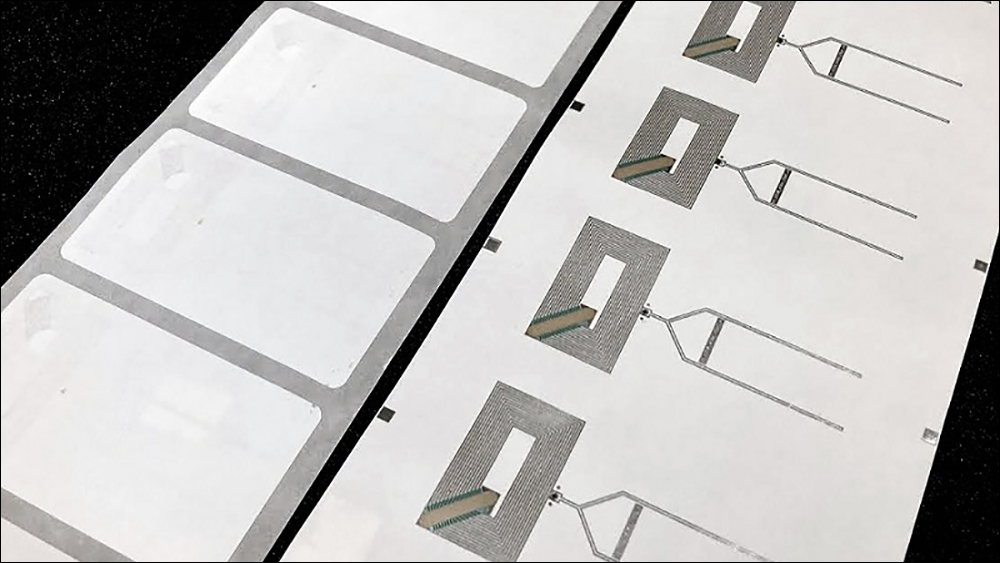Feb 15, 2023RFID Journal LIVE! 2023 will feature vendors showcasing NFC and RFID tagging solutions designed to reduce energy consumption, as well as exhibitors offering tagging solutions for multiple applications. To learn more, visit the event's website.
- Eco-Friendly Tag's Main Features
- Preventing Fraud with a Destructible Antenna
- Expanding the Use of NFC Technology
Global communication, security, electronics and packaging company Toppan has released a new Near Field Communication (NFC) tag label designed to reduce the environmental impact compared to that of conventional NFC tags. The Eco-Friendly NFC Tag Label uses paper as its substrate—the surface on which the antenna is applied—providing an alternative to conventional polyethylene terephthalate (PET) film, the company reports. The label leverages circuit-fabrication technology intended to deliver tag performance at the same level as standard tags. The label also comes with a feature to prevent fraudulent reattachment if it is removed from another product.
The use of paper substrates for NFC tags is not new, as such tags have been available with antennas formed or printed on paper substrates for at least 10 years, according to Takamitsu Nakabayashi, Toppan's general manager of RFID, Internet of Things and security development. Until now, though, the common manufacturing method for those products has involved using conductive inks to print the antenna onto the paper substrate. This can reduce performance compared to standard tags. The Eco-Friendly tag, the company explains, is designed to avoid this performance compromise.

The Eco-Friendly NFC Tag Label
Toppan is a global company founded in 1900, and it now has 54,000 employees, as well as customers and suppliers across the globe. To fulfill its self-determined responsibilities and mission, Toppan established an action plan to address United Nations Sustainable Development Goals (SDGs) in 2019, which include creating a circular economy, decarbonizing, and expanding the use of eco-friendly products and solutions. Since setting out specific sustainability targets, the company says it has gained on its efforts to achieve them.
Toppan's intention, Nakabayashi says, is to "analyze climate-change risks and opportunities, consider countermeasures, and disclose relevant information." In this effort, he adds, "We are also focusing on addressing the SDGs in our RFID business and advancing the development of more eco-friendly products." To that end, Toppan developed a UHF RFID model as part of its Smartics-u series in 2021. "The number of RFID devices using paper substrates is still quite small in the industry, but we expect the number of sustainable RFID products to increase going forward."
Eco-Friendly Tag's Main Features
For more than a decade, Toppan has been developing and improving its printed antennas. In 2010, the company announced the development of a flexographic printing method to print antennas for UHF RFID tags, which could be printed directly onto paper containers such as packaging boxes. The demand targeted at the time was related to source tagging (tagging products or packaging at the production site), and it was developed as a technology for building antennas directly onto packaging materials.

Takamitsu Nakabayashi
"Today, we are seeing a gradual uptick in demand for more eco-friendly solutions in the RFID industry," Nakabayashi reports, "against a backdrop of demand for more eco-friendly solutions in general throughout the world." One key differentiator for Toppan's Eco-Friendly NFC Tag Label is the use of paper for the antenna substrate, which eliminates the need for plastics found in conventional RFID tags in the PET film substrate.
According to Toppan, the new NFC tag comes with a feature intended to improve performance. The tag features the formation of an antenna circuit using aluminum foil. Typically, antenna circuits using conductive inks can increase a circuit's electrical resistance, which negatively impacts the tag's transmission performance. To address this problem, Toppan created the antenna circuit on a paper substrate using its new circuit fabrication technology, which combines laser-edge technology with a roll-to-roll web-handling process. This forms a circuit using aluminum foil, which has low electrical resistance.
The new NFC tag is compatible with a diverse range of IC chips, Toppan reports. The tag's basic model leverages NXP Semiconductors' NTAG series and ICODE series, STMicroelectronics' ST25TV ICs or Fudan Micro's FM13HF02 chips. A security model comes with NXP's NTAG DNA series, EM Microelectronic's EM4425, Silicon Craft's SIC43NT or Fudan's FM13HS01.
Preventing Fraud with a Destructible Antenna
The tag's design takes advantage of the use of a paper substrate to introduce fraud prevention, Toppan explains. Paper tears easily, Nakabayashi explains, and if someone were to attempt to remove a tag that was attached to a product using an adhesive, that action would cause the substrate to tear, because the strength of the adhesive is greater than that of the paper substrate.
Nakabayashi says Toppan has a foundation of technologies built up in the security printing business, such as for securities and holograms. By combining various security-processing technologies such as slit processing, he explains, "We have been able to make the substrate more brittle."
The tag label featured in a press release measures 45 millimeters by 80 millimeters (1.8 inches by 3.1 inches). If conventional labels of the same size were replaced with the Eco-Friendly NFC Tag Label, the company says one million labels would reduce plastic consumption by approximately 110 kilograms (243 pounds).
Additionally, according to Nakabayashi, if a white label were used, the paper substrate would function as the outer layer, making the label thinner than conventional products with plastic film substrates. For example, while the label-layer thickness of a conventional product is about 150 micrometers (0.006 inch), the thickness of the Eco-Friendly NFC Tag's label layer is around 100 micrometers (0.004 inch).
Expanding the Use of NFC Technology
A digital transformation is already underway, Nakabayashi says. Against that backdrop, he adds, "We expect demand for attaching NFC labels to individual items to expand significantly in various sectors." Consumer engagement is one example. The tags will be applied to the products with which consumers wish to engage, enabling them to confirm authenticity, learn more about those items, or order replacements or accompanying products.
For instance, a consumer could tap their NFC-enabled smartphone against the label of luxury cosmetics or a bottle of liquor to obtain loyalty points, as well as watch videos about the product or learn how it was made. Tags on pharmaceuticals could similarly provide information about the medications and how they can be used safely.
Companies employing the new labels will gain a sustainability benefit, Nakabayashi says, but without compromised RF transmission performance. "For customers who have been targeting eco-friendliness by using NFC tags with antenna circuits printed on a paper substrate," he states, "using our new product with its aluminum foil antenna circuit improves communication performance."
The flexibility of the thinner paper substrate label is intended to serve applications in which a product has a curved surface. With PET film substrates, the relative stiffness of the substrates can cause labels to peel off when attached to curved surfaces. Several Toppan customers are considering adopting this product, Nakabayashi says, and all have indicated their interest is due to its reduced environmental impact. The tag is commercially available now for orders in volume, and the company may add a business model down the line for recovering and recycling tags after use.
Key Takeaways:
- Toppan's Eco-Friendly NFC Tag Label joins its product portfolio of electronic products that leverage paper substrates as a more sustainable alternative to plastics-based standard tags.
- The label is designed for higher performance with aluminum foil circuitry, and it prevents fraudulent use with a design by which the antenna destructs when removed from a package or product.

